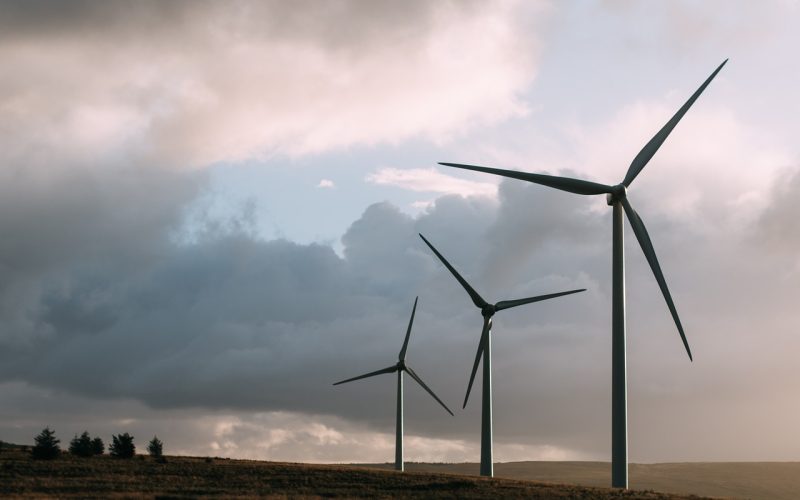Big Pinwheels in the Sky

We are publishing this article by Katelyn Jasmin, a Research Assistant at the University of Michigan Ford School of Public Policy’s Center for Local, State, and Urban Policy (CLOSUP), that discusses the attitudes of local government leaders in Michigan, particularly in the Upper Peninsula, towards wind energy.
Katelyn highlights that a significant majority of UP officials oppose large-scale wind projects within their own jurisdictions, though there is slightly more support for wind energy statewide, and emphasizes the need for a balanced approach to sustainability and the potential conflicts between state and local priorities regarding renewable energy development.
This is the second in a series from the “CLOSE UP on the UP” project, a collaboration between CLOSUP, U-M’s UP Scholars Program, and Rural Insights.
A team of undergraduate students from the UP who attend the University of Michigan are using CLOSUP survey data, with a particular emphasis on the responses from over 130 local governments in Michigan’s Upper Peninsula who respond each survey wave, to look at issues important to their home region and analyze the insights of the UP’s local government leaders.
Special note from CLOSUP:
If you are a UP county, city, village, or township official, please consider participating in the Spring 2024 wave of the Michigan Public Policy Survey (MPPS) from the University of Michigan’s Center for Local, State, and Urban Policy (CLOSUP). It’s important for the survey findings to include UP governments’ perspectives on questions about the challenges facing local communities across the state. This year’s survey is asking about public safety in your jurisdiction and law enforcement practices across the state. Please make sure your UP government’s voice is heard.
When I was a young child, I saw my first wind turbine in the hills of Iowa when my family was driving from Michigan to Colorado. Many people consider them an eyesore, but I thought they looked absolutely wonderful. They were like giant pinwheels that I thought could fly into the sky at any moment. Soaring through the clouds like an adventurer that doesn’t know where they’re going, but simply enjoying the journey. Quite a dazzling life to give a wind turbine, isn’t it?
The reality of these giants is less fantastical, however. Wind turbines are part of a bigger discussion on renewable energy and sustainability as a whole. There have been discussions in both state and the federal governments if they should be used as an alternative source of energy rather than fossil fuels in order to reduce carbon emissions. In Michigan, though, opinions on this renewable energy source are complex. So, in this article, let’s look at the attitudes of Michigan local government leaders, particularly those of the Upper Peninsula, toward wind energy.
In fall 2023, the University of Michigan’s Center for Local, State, and Urban Policy (CLOSUP) conducted a statewide survey on energy issues. According to CLOSUP’s survey data, around two-thirds (~66%) of the local officials in U.P. counties, cities, villages, and townships (the respondents of the survey) oppose large scale wind projects in their own jurisdiction (see Figure 1 below).
Figure 1: Local leaders’ support for or opposition to new development of large-scale wind projects in their own jurisdiction, separated by region (Fall 2023 MPPS)
As for increasing wind energy on land generally across the state, the divide between those who support and oppose it is more evenly split, but still around half of local leaders statewide oppose it. When it comes to increased offshore wind energy on the Great Lakes, there’s even less support. The percentages vary, but one commonality is that either “strongly support” or “don’t know” is always the lowest.
Figure 2: Local leaders’ support for or opposition to new development of large-scale wind projects across Michigan, separated by region (Fall 2023 MPPS)
This data is particularly intriguing because there’s such a strong opposition to large wind projects with one’s own jurisdiction, but that strong opposition is halved when it comes to increasing wind energy in the state overall. This may be due to the “Not In My Back Yard” syndrome; people like the idea of developing wind energy, but not where they live. The U.P. officials’ assessments are also interesting because they generally parallel the overall opinions of Lower Peninsula leaders on land-based wind, but when it comes to increasing offshore wind energy, there is less support among local leaders in the U.P. than among those in the Lower Peninsula.
Opposition to wind energy wasn’t always this strong in the state, however. A decade ago, in 2013, CLOSUP conducted a different survey that asked the opinions of local government officials on issues related to wind energy. The results, shown below in Figure 3, are surprising when one compares the answers to the 2023 data.
Figure 3: U.P. local leaders’ support for or opposition to expansion of wind energy across Michigan (Fall 2013 vs. Fall 2023 MPPS)
There previously was much more support for wind energy among Michigan officials, including those from the U.P. The support for wind projects within one’s own jurisdiction and expansion of land-based wind energy was much more positive. In both areas, the percentage of those who said ‘strongly oppose’ is a fraction of the amount today. Overall, the majority (81%) of local government officials in the U.P. back in 2013 supported additional land-based wind energy across the state. Today, only 46% support increasing land-based wind energy in the state, and only 31% support expanding off-shore wind.
Historically, U.P. officials had a more enthusiastic attitude about the future prospects of wind energy, which is a stark contrast to many attitudes today. So, we may ask ourselves: well, how did we get here?
For starters, wind energy isn’t the perfect renewable energy option; like all types of energy production, it has its drawbacks. These include visual or noise impacts (this was the biggest discouraging factor for the development of wind energy in 2013 as reported by local officials at the time), negative impacts on local wildlife, lack of efficiency as they can only be placed in areas with consistent wind, and potential environmental impacts (particularly if they’re built offshore). However, there may be a more intricate reason at play here.
Michigan, particularly the Upper Peninsula, is heavily dependent on its tourism industry; for the U.P., it’s a strong source of economic income. As a result, the state spends a lot of time and money advertising its untold natural gems to the outside world and prioritizes keeping them in optimal condition. What’s Michigan’s primary golden goose? The Great Lakes! Particularly, the ethereal coastline view. As someone from a Michigan coastal town, I can attest to this from seeing the multitude of hotels blocking said view so that their customers can pay to see it. Given that many people find wind turbines visually unappealing, putting them offshore would impact the picturesque view that many tourists come to Michigan to see. This is especially tricky since the most optimal place to put the turbines is on the coastline, the area with the greatest amount of wind. This may explain why support for offshore wind energy was even lower than land-based wind energy among the U.P. jurisdictions.
There’s a tragic irony to this, however. The main reason renewable energy is needed is because our reliance on fossil fuel energy contributes vast amounts to CO2 emissions, which in turn contributes to climate change. As a result of the changing climate, the U.P. and Michigan as a whole is seeing less and less snowfall. Going back to Marquette from Ann Arbor this past winter, I remember there being only two days where it snowed. This is concerning because the U.P. relies not only on summer tourism, but winter tourism as well. With no snow, there was a devastating hit to winter tourism businesses in the U.P. Not to mention that because of increased temperatures, there’s an increased chance of forest fires during the summer, which can lead to health impacts from smoke inhalation. During the Canada forest fires last summer, the U.P. was covered in smoke and it was hard to breathe when one went outside. No one wants to go outside when they feel like they’re going to be poisoned.
Our reliance on tourism is preventing us from making the necessary changes to prevent the worst impacts of climate change…but this lack of change is also what’s leading the industry to be strangled.
It’s important to consider the deeper aspects of Michigan’s change in opinion on wind energy as both the state and the U.S. itself needs to take large measures in order to reach our sustainability goals. The world is at a tipping point with climate change and if the most severe impacts of it are to be prevented, the whole world needs to make the necessary advances in sustainability in order to lower carbon emissions (particularly high-emitting countries like the U.S.). Governor Gretchen Whitmer, for example, has made competing for additional clean energy projects one of her priorities for her second term. The resistance to develop clean energy projects, like wind energy, in Michigan jurisdictions jeopardizes the state government’s sustainability goals. This could cause conflicts between the two levels of government as the State turns to preemption in order to move clean energy projects forward. This could also increase tensions between rural and urban communities as most wind energy projects will be in rural areas.
So, what are our next steps?
I want to make it clear that this article isn’t advocating for the support or opposition of wind energy. As mentioned before, it’s not a perfect option and it might not even be the best one for the U.P or Michigan as a whole. However, the deterioration of support for it over the past 10 years points to a deeper issue of sustainability in Michigan. It’s important that we Michiganders question if our reliance on tourism is holding us back from advancing toward a greener, more sustainable future.
In the end, tourism may be more of a detriment for the U.P. than a benefit. Yes, it provides job opportunities and economic income to the region, but the industry is showing the first signs of dying as a result of the onset of climate change. Who knows, in just another ten years, it could be in its grave. Where will that leave the business and people who rely on it? Where will it leave the U.P.?
Not to mention that there’s clear negatives of the tourism industry. For one thing, it carves up the communities we hold dear; my friends in Marquette have told me how many of the places they loved growing up were closed down and replaced by hotels for tourists. Another thing is that while local and state governments maintain environmental spaces, they often do so from a financially motivated stance; they mold them into what they think tourists want because at the end of the day tourists are their highest priority, not the local communities or environments.
It’s time that we become self-reliant, focusing on growing and improving our communities. We have so much opportunity to expand our horizons and explore avenues that we had never previously dreamed of. Though, it’s important that we always think conscientiously while we do this, so that we can build a community where we work with our environment instead of against it. We can’t equate progress and development with the sacrifice of the natural environment.
This is the vision I have for Michigan and my U.P. community. I think we truly have the ability to build a better future where we can be free from the confines of industrialization and live in a way that sustains everything and everyone for generations to come. I’ve always looked at things through a fantastical lens, in which there can be giant pinwheels flying through the sky. Yet, I think this vision is something that can come true if we look at the world around us and grow towards a more sustainable way of living, wind energy or no wind energy.
***
This article draws on data from statewide surveys of local government leaders from the Michigan Public Policy Survey (MPPS). Since 2009, the University of Michigan’s Center for Local, State, and Urban Policy (CLOSUP) has conducted the MPPS to gather the insights and concerns of elected and appointed officials from all 1,856 of Michigan’s general purpose local governments on a wide variety of topics.
The fall 2023 wave received responses from 135 Upper Peninsula jurisdictions. The fall 2013 wave received responses from 142 Upper Peninsula jurisdictions.
CLOSUP staff are available to answer questions and help interpret the data (by email at closup-mpps@umich.edu or by phone at 734-647-4091).
For more information about the MPPS program, see: https://closup.umich.edu/michigan-public-policy-survey. And for more information about U-M’s UP Scholars program, see: https://lsa.umich.edu/scholarships/UPScholars.html









Another wonderful article. Thank you Rural Insights! Could you please have Katelyn please contact me? I would love to have her speak at our township meeting in the UP! Thank you!
I think a lot of the people who hate wind energy also hate tourists, so I don’t think opposition to off-shore windmills comes from wanting things to be nice for the tourists. It’s much more likely that people don’t want their own views of the lakes–or the forests–disturbed.
But ultimately this comes down to the culture wars. We used to be pretty united in protecting the environment but then that became something that only woke sissies cared about while real men wanted their gas-guzzling cars and their incandescent light bulbs.
Excellent article. Very interesting and relevant.
Tad
Does the UP have any wind turbines? I see the 2 at the bridge and I marvel at the free clean energy. Perhaps rural areas have been spoiled by the gross misinformation by trump that these wind turbines emit cancer and all the other rhetoric descriptions trump has put forth. I went through Canada on the way to Niagara Falls from Detroit and saw hundreds of windmills off the highway. If these wind turbines can save fossil fuels than I am for it. Solar is another form that can help save our only planet. Perhaps cell towers can also be incorporated in these wind turbines for multi purpose use. Do we need a fifty-first state?
James,
There are turbines in the garden peninsula. There was an attempt to place them in Cooks, but it turned into a nasty fight. The back story is long. Needless to say Bay de Noc school district became solvent by using tax revenue generated from windmills.
Alot of it is Nimbyism. Industrial solar is also facing the same headwinds- i.e. Cornell, St Nicholas area’
Very well written article, but would like to see the perspective from the landowners who attempted to place turbines on their property and were zoned out by local planning commissions and township boards.
I live in south Texas part of the year and the UP the other part. Seems to me that there is a lot of misinformation on how much energy is produced by these things, life expectancy, and the problem of their disposal once they run their course. You can’t go anywhere in Texas without seeing them. All along the coast, all over the plateau and mesas of West Texas. All covered with red blinking lights at night for obvious reasons. Completely ruining the views and beauty of many areas of the once picturesque state.
Hear, Hear! The shift in attitude is because more of us are seeing the actual results of wind turbines, and it is not all good, and it certainly is not free as a previous poster mentioned.
The final answer and solution to the energy issue is not wind or solar. It is small, modern, modular nuclear energy.
I’m a relocated Yooper and live and work in Illinois. I’m also a U of M alum. We have thousands of these units installed across the State. There’s a huge carbon footprint associated with their production, and the disposal is a large problem as the fiberglass blades cannot be recycled. Their estimated lifetime is approximately 30-35 years. They have a 40 percent capacity factor (the amount of time they actually produce power). At this rate it takes about 30 -35 years to produce as much electricity as it took to make these things in the first place.
There are many negatives associated with living near one, particularly in the shadow with light flicker headaches, ground vibrations, and some constant noise.
In Illinois and at the Federal level, there are tax incentives for installing these, so that the large companies or the venture capital they represent can offset other income.
Modular, small scale nuclear power is a much better option and much less of an eyesore.
Near the LaSalle nuclear station, which produces 2500 MWe, at a 98 percent capacity factor, there’s a wind farm with 550 turbines. Each occupies 1/3 acre, or 183 acres and each produces 1.1 MWe at 40%. The Nuclear plant occupies 10 acres. Do the math.
“Thanks to the direct use of fossil fuels, the world can have paved roads, bridges made of steel, and electricity transmission lines. It can have concrete. It can have pharmaceutical products, herbicides, and insecticides. Many of these benefits come from the chemical properties of fossil fuels. Electricity, by itself, could never provide these products since it has been stripped of the chemical benefits of fossil fuels. Electricity is also difficult to store.”
Quoted from the latest post from Our Finite World, a blog that examines “how oil limits affect the economy” with numerous related posts worth reading: https://ourfiniteworld.com/
Am not a fan of pharma or toxic chemicals, but much else of what we count on cannot be done with alt energy resources.